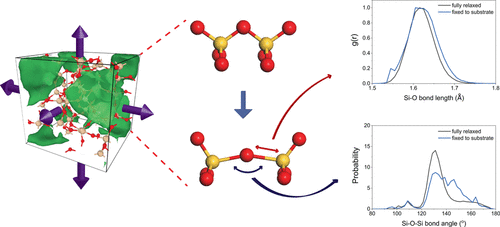当前位置:
X-MOL 学术
›
ACS Appl. Mater. Interfaces
›
论文详情
Our official English website, www.x-mol.net, welcomes your
feedback! (Note: you will need to create a separate account there.)
Estimating Internal Stress of an Alteration Layer Formed on Corroded Boroaluminosilicate Glass through Spectroscopic Ellipsometry Analysis
ACS Applied Materials & Interfaces ( IF 8.3 ) Pub Date : 2021-10-13 , DOI: 10.1021/acsami.1c10134 Huseyin Kaya 1 , Dien Ngo 2 , Seung Ho Hahn 3 , Mingxiao Li 2 , Hongtu He 2, 4 , Beyza Yedikardeş 5 , İlkay Sökmen 5 , Christian W Pester 1, 2, 6 , Nikolas J Podraza 7, 8 , Stephane Gin 9 , Seong H Kim 1, 2
ACS Applied Materials & Interfaces ( IF 8.3 ) Pub Date : 2021-10-13 , DOI: 10.1021/acsami.1c10134 Huseyin Kaya 1 , Dien Ngo 2 , Seung Ho Hahn 3 , Mingxiao Li 2 , Hongtu He 2, 4 , Beyza Yedikardeş 5 , İlkay Sökmen 5 , Christian W Pester 1, 2, 6 , Nikolas J Podraza 7, 8 , Stephane Gin 9 , Seong H Kim 1, 2
Affiliation

|
Aqueous corrosion of glass may result in the formation of an alteration layer in the glass surface of which chemical composition and network structure are different from those of the bulk glass. Since corrosion occurs far below the glass-transition temperature, the alteration layer cannot fully relax to the new structure with the lowest possible energy. Molecular dynamics simulations suggested that such a network will contain highly strained chemical bonds, which can be manifested as a stress in the alteration layer. Common techniques to measure stress in thin films or surface layers were found inadequate for thick monolithic glass samples corroded in water. Here, we explored the use of spectroscopic ellipsometry to test the presence of internal stress in the alteration layer formed by aqueous corrosion of glass. A procedure for analyses of spectroscopic ellipsometry data to determine birefringence in the alteration layer was developed. Findings with the established fitting procedure suggested that a stress builds up in the corroded surface layer of a boroaluminosilicate glass if there is a change in relative humidity, pH, or electrolyte concentration of the environment to which the glass surface is exposed. A similar process may occur in other types of glass, and it may affect the surface properties of corroded glass objects.
中文翻译:

通过光谱椭偏分析估计腐蚀硼铝硅酸盐玻璃上形成的变化层的内部应力
玻璃的水腐蚀可能导致在玻璃表面形成化学成分和网络结构与块状玻璃不同的变质层。由于腐蚀发生在远低于玻璃化转变温度的情况下,因此蚀变层无法以尽可能低的能量完全松弛到新结构。分子动力学模拟表明,这样的网络将包含高度应变的化学键,这可以表现为蚀变层中的应力。发现测量薄膜或表面层应力的常用技术不适用于在水中腐蚀的厚单片玻璃样品。在这里,我们探索了使用光谱椭偏法来测试由玻璃的水腐蚀形成的蚀变层中内应力的存在。开发了一种用于分析光谱椭偏数据以确定蚀变层中的双折射的程序。已建立的拟合程序的结果表明,如果玻璃表面暴露的环境的相对湿度、pH 值或电解质浓度发生变化,则应力会在硼铝硅酸盐玻璃的腐蚀表面层中积聚。类似的过程可能发生在其他类型的玻璃中,它可能会影响被腐蚀的玻璃物体的表面特性。或玻璃表面所暴露环境的电解质浓度。类似的过程可能发生在其他类型的玻璃中,它可能会影响被腐蚀的玻璃物体的表面特性。或玻璃表面所暴露环境的电解质浓度。类似的过程可能发生在其他类型的玻璃中,它可能会影响被腐蚀的玻璃物体的表面特性。
更新日期:2021-10-27
中文翻译:

通过光谱椭偏分析估计腐蚀硼铝硅酸盐玻璃上形成的变化层的内部应力
玻璃的水腐蚀可能导致在玻璃表面形成化学成分和网络结构与块状玻璃不同的变质层。由于腐蚀发生在远低于玻璃化转变温度的情况下,因此蚀变层无法以尽可能低的能量完全松弛到新结构。分子动力学模拟表明,这样的网络将包含高度应变的化学键,这可以表现为蚀变层中的应力。发现测量薄膜或表面层应力的常用技术不适用于在水中腐蚀的厚单片玻璃样品。在这里,我们探索了使用光谱椭偏法来测试由玻璃的水腐蚀形成的蚀变层中内应力的存在。开发了一种用于分析光谱椭偏数据以确定蚀变层中的双折射的程序。已建立的拟合程序的结果表明,如果玻璃表面暴露的环境的相对湿度、pH 值或电解质浓度发生变化,则应力会在硼铝硅酸盐玻璃的腐蚀表面层中积聚。类似的过程可能发生在其他类型的玻璃中,它可能会影响被腐蚀的玻璃物体的表面特性。或玻璃表面所暴露环境的电解质浓度。类似的过程可能发生在其他类型的玻璃中,它可能会影响被腐蚀的玻璃物体的表面特性。或玻璃表面所暴露环境的电解质浓度。类似的过程可能发生在其他类型的玻璃中,它可能会影响被腐蚀的玻璃物体的表面特性。











































 京公网安备 11010802027423号
京公网安备 11010802027423号